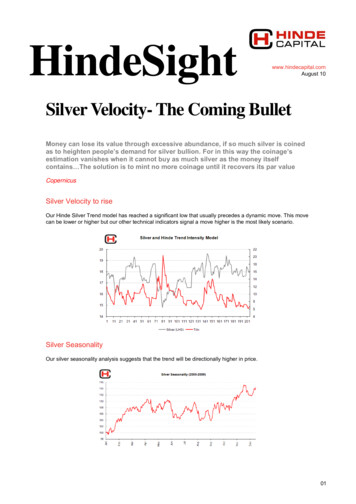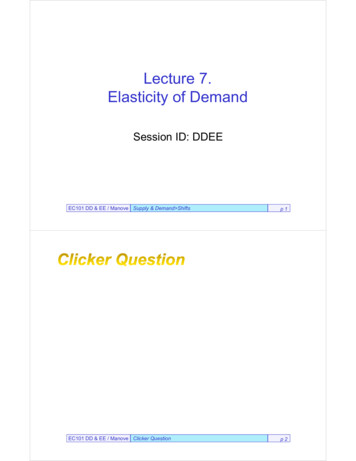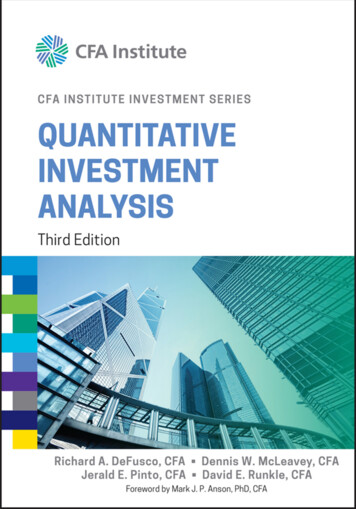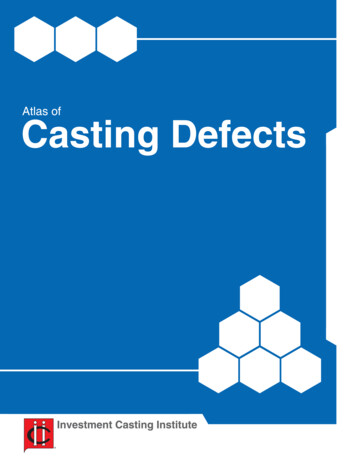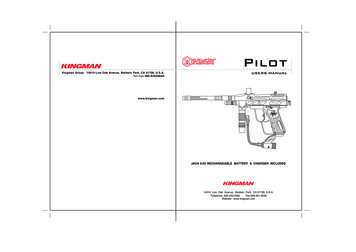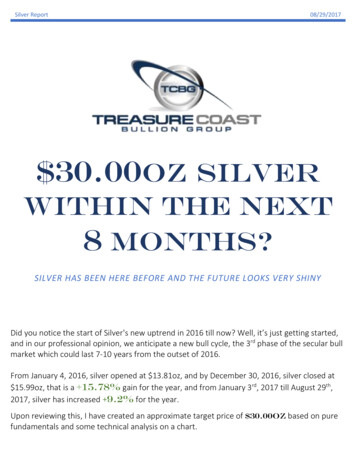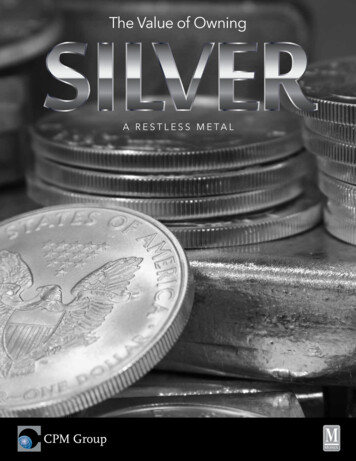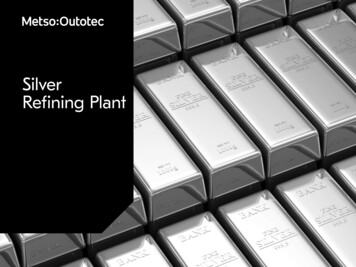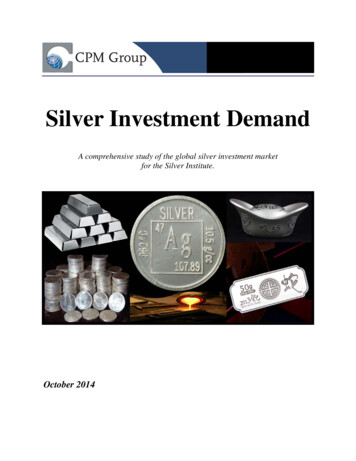
Transcription
CPM GROUPSILVER INVESTMENT DEMAND 2014Silver Investment DemandA comprehensive study of the global silver investment marketfor the Silver Institute.October 20141
DISCLAIMERCPM GROUPSILVER INVESTMENT DEMAND 2014NOT FOR REPRODUCTION, DISTRIBUTION, OR RETRANSMISSION WITHOUT WRITTENCPM GROUP OR SILVER INSTITUTE CONSENT. INFORMATION IN THIS REPORT MAY BEREFERENCED AT WILL WITH PROPER ATTRIBUTION TO THE SOURCE.This report has been produced to print two-sided with proper pagination.CPM Group30 Broad Street37th FloorNew York, NY oup.comJeffrey M. Christian, Managing DirectorDoug Sherrod, Managing Director, Investment BankingCarlos Sanchez, Director of Risk ManagementMelissa Rivera, AdministratorElliot Kalson, Chief Operating OfficerCatherine Virga, DirectorRohit Savant, Director of Research, Senior Research AnalystMu Li, Director of Base and Specialty Metals Research, Senior Research AnalystMadhusudan Daga, ConsultantBhargava Vaidya, ConsultantOctober 2014Copyright The Silver Institute 2014.This report has been produced by CPM Group for distribution by the Silver Institute. The rights to distribution andreproduction of this report are ceded to the Silver Institute by CPM Group. The intellectual content and propertyremain the property of CPM Group, and they are not for reproduction or retransmission without written consent ofCPM Group. Opinions expressed here represent those of CPM Group at the time of publication. Any statementsnon-factual in nature constitute only current CPM Group opinions, which are subject to change. The informationcontained here has been obtained from sources CPM Group believes to be reliable, but CPM Group does notguarantee its accuracy or completeness. While every effort has been made to ensure that the accuracy of the material contained in the reports is correct, CPM Group and the Silver Institute cannot be held liable for errors oromissions. This material is for private use of readers only. CPM Group and the Silver Institute are not solicitingany action based on it. Information contained here should not be relied on as specific investment or market timingadvice. At times the principals and associates of CPM Group may have long or short positions in some of the markets mentioned here.2
TABLE OF CONTENTSPrologueCPM GROUPSILVER INVESTMENT DEMAND 20145Investment Demand and Silver Prices 8The Relationship of Investment Demand to Silver Prices Historically 10The Outlook For Silver Investment Demand 14The Demographic and Geographic Dispersion of Silver Investors 16Why Invest In Silver 19Silver As A Financial Asset 20Silver and Inflation 20Silver and the Dollar 22Silver As An Industrial Commodity 25Silver and Gold 28Silver and Interest Rates 31Silver as a Portfolio Diversifier 32Silver Investment Vehicles 37Bullion and Coins 37Futures and Options 40Exchange Traded Products 42Silver Mining Equities 43Silver Investment Holdings 453
CPM GROUPSILVER INVESTMENT DEMAND 20144
CPM GROUPSILVER INVESTMENT DEMAND 2014PROLOGUEPrologueClients around the world sometimes have us discuss the long history of silver as a financial asset and investment. In such presentations and discussions we sometimes find ourselves pointing out that when the Communist Party took control of mainland China in 1949 the main currencies used in everyday life in China wereSpanish, U.S., and Cuban silver coins. China had been wracked by internal turmoil and external attacks for thebetter part of the previous four centuries. During that time there often were no strong central governmentsclearly in control and often no central currency as readily accepted to settle transactions as silver. During thisperiod hundreds of million if not billions of ounces of silver were imported into China, including a great volume of Spanish silver coins minted in Mexico.When people express surprise at silver’s role as the de facto Chinese currency of choice for such a long periodof time, we turn the discussion to the U.S. experience. Prior to the creation of the ‘greenback’ national currency during the Civil War, and even after that until the establishment of a stronger national banking systemunder the Federal Reserve System after 1913, most of the currency circulating in the United States were banknotes printed by private banks, mostly privately owned local banks. Most of these banks, and there were tensof thousands of them, were state chartered banks, and most states did not have any real capacity to regulateand supervise the banks in their jurisdictions, including auditing the banks to make sure they were functioningsafely and actually had reserves to back the private bank notes they were issuing. Banks regularly printedmoney, bank notes, far in excess of any deposits of gold, silver, or other currencies (bank notes from otherbanks, U.S. greenbacks). This led to frequent bank panics and runs on banks, as depositors realized theirmoney had been squandered, which led to frequent recessions and depressions. Few people who hark back tothe good old days of U.S. finance prior to the establishment of the Fed realize that the U.S. experienced threedepressions over three decades, in 1873 - 1879, 1882 - 1885, and 1893 (a series of three recessions that lasteduntil 1900), all precipitated by private bank malfeasance in the system that existed prior to the Fed. The Fed’screation owes itself to the Bank Panic of 1907, which led to a period in which the U.S. economy experienced aseries of severe recessions for 60 of the 90 months from May 1907 until December 1914.During this time, America was growing rapidly. People were migrating to the United States from all over theworld, and internal migration within the country was enormous. People would arrive at ports around the country with foreign currencies, gold, and silver, to start their new lives in America. The most useful and mostreadily accepted forms of currencies were gold and silver, and silver constituted the bulk of what people carried. Silver was more able to be saved, and was in more useful denominations for everyday transactions.The same was even more true regarding migration within the United States. A family moving from Pennsylvania, Ohio, or Minnesota to start a new life in Kansas, Nebraska, or California could carry with it bank notesissued by private local banks that were unknown in the new territories or anywhere else, or they could carrygold and silver. Again, silver was the more useful of the two precious metals for carrying one’s wealth andundertaking everyday transactions. Spanish “Pieces of Eight” perhaps were the most common currency used inthe Middle West and western parts of the United States.The alternative to silver and gold was that a person moving from one place to another carrying private banknotes faced the prospect of his currency not being accepted anywhere but at his old home. Bankers, shopkeepers, feed stores, realtors, and others had enormous books with hand-printed drawings of the tens of thousandsof private bank notes being issued throughout the country. They would have to compare the bank notes beingpresented to them by would-be buyers of their goods and services to the drawings in the book to make a judgment as to whether the bank notes were genuine or not. Bank note designs also changed regularly at the time,and local banks closed down all the time, so the books were quickly out of date. Even if the notes appearedgenuine, and not forged, the sellers or bankers had to take the chance that a private, almost entirely unregulated bank somewhere far away was being run honestly and would honor its notes when they were turned infor greenbacks, gold, or silver.5
PROLOGUECPM GROUPSILVER INVESTMENT DEMAND 2014These two examples set the stage for this report, exploring and explaining why savers and investors love silver.Stacking Is InvestingA third story helps further clarify and expand the subject. In late 2013 I became engaged in a discussion on achat-room entitled silverstackers.com. Over a period of several days we had a very lively and interesting discussion of silver market trends and conditions. At one point one participant made a comment that hit home andstuck with me. I had written something about investing in silver, and the respondent said, in essence, ‘with duerespect Mr. Christian, you need to know that we do not invest in silver, we stack it.’ He meant that they did notsee silver as an investment, but as a store of wealth, an alternative to holding one’s wealth in a nationally issued currency such as the U.S. dollar. That comment contains profound wisdom, even as it also misses a keypoint.Many people confuse investing with trading these days. Investing is not limited to shorter term buying, holding, and later selling assets. That is one form of investing, but the concept of investing is much broader andbigger, much more significant than merely such short-term transactions. Indeed, by most definitions and certainly in my mind, investing is much more a buying and holding activity, stacking silver if you wish, than it isthe shorter term activities. Those shorter term activities sometimes are called speculating, and sometimes thatis all they are. More often these transactions are taken by longer term investors seeking to earn a slightlyhigher return on his or her investments by switching among assets frequently – like the frenetic driver con-Investors Stack Silver High, In Coin and Bar FormsA total of 60 million ounces of silver, in the form of 60,000 1,000-ounce bullion bars, were held at a depositoryby the Wilmington Trust in 1995, when this photo was taken.6
INTRODUCTIONCPM GROUPSILVER INVESTMENT DEMAND 2014stantly shifting lanes on a highway in the hopes of getting there a little bit faster. Investing is, primarily, a long-term activity, and it includes, or should for astute investors, considerations of the currencies in which one denominates one’s long-term asset holdings, including silver.Investors sometimes do not see themselves as investors. We have seen mining companies hold some of theirexcess returns in gold, silver, copper, aluminum inventories of their products. They are in essence investingin these metals. They often do not see themselves as investors, but in effect that is what they are doing: Investing in their own products in the expectation of higher prices later, rather than exchanging their output for cashimmediately on outturn. This activity of producers and other commercial intermediaries holding metal in inventories for any of a number of reasons is something that confounds casual market observers, who often inaccurately assume that any surplus of newly refined metal over fabrication demand is by definition investmentdemand. It is, in a way, but some of those investors may be miners, smelters, refiners, warehouse managers,industrial users, or others who are not investing based on common investment principles, but rather based oncommercial considerations particular to their company’s financial and operational situation and market conditions at the time. Also, market makers, banks and merchants who stand to buy or sell in the market for purposes of providing liquid two-way markets to commercial and investment entities, often find themselves holding inventories during periods of time when others simply do not want all the metal that is on offer for sale in agiven metal or commodity.These nuances aside, the silver stacker’s comment was very profound and telling of the role of silver investing. Many investors buy and hold silver not as an investment in any short-term or speculative sense of theword, but as a core part of their long-term assets, the base in some cases of the individual’s wealth. In this waytheir silver holdings, investments if you will grant us permission to use this word in its broadest sense, aresomething much more meaningful and visceral to the owners than shares in a stock or a series of bonds theymay hold for a period of time.CPM Group is pleased the Silver Institute has worked with our firm to produce a comprehensive report on thesubject of silver investment markets.Jeffrey M. ChristianManaging PartnerCPM Group LLCOctober 20147
CPM GROUPSILVER INVESTMENT DEMAND 2014PRICE FORECAST: BASE CASEInvestment Demand and Silver PricesInvestment demand is the single most important driver of prices in the silver market.Historically, investors have not always been net buyers of the metal, as they are now and have beensince 2006. Over the years they have bought or sold silver on a net basis, taking into account a range ofeconomic, financial, political, and silver market fundamentals in deciding when to be adding silver totheir holdings, and when to be divesting. There have been periods when investors sold enormousamounts of silver into a market that had supply shortfalls, keeping prices at stable or even low levels.There also have been periods when investors have massively increased their holdings of the metal, bidding prices sharply higher in order to attract metal that otherwise would have either gone into fabricatedproducts or been stacked up by market-making dealers. The amount of silver that is being added to orreleased from investor inventories has had a crucial impact on the silver market, moving prices dramatically in either direction.The current period of investor buying, which began in 2006, is the third time that investors have shiftedinto this role of net accumulators of silver in modern market history. This shift has been and continues tohave profound effects on silver prices. It is the key to understanding why prices have risen sharply since2006, reached a cyclical peak of 49.82 in April 2011, and why they have remained at historically elevated levels since then. The driving force behind such strong price momentum has been persistentlystrong investor buying, on top of higher trending fabrication demand for silver. During the eight yearsbetween 2006 and 2013, investors have bought about 862.1 million ounces of silver on a net basis, compared to net sales of 1,701.0 million ounces of silver during the previous period between 1991 and 2005.The fluctuations of silver prices, in turn, also affect levels of investment demand. It was easy for manyinvestors to be bullish about silver’s price prospects when prices languished below 5.00 in 2001 –2003. It was easy for some of those investors to decide to capitalize their gains after the price spikedsharply higher in April 2011 and then came off sharply.Silver Market BalanceProjected Through 2014, Prices through 2013Million Ounces250 /Ounce50Net Additions45Net Changes in Inventories2004015035100305025020-50Price (LHS)15-10010-1505-200Net Withdrawals060646872768084-250889296000408128
PRICE FORECAST: BASE CASECPM GROUPSILVER INVESTMENT DEMAND 2014One key factor in the silver market, as with all precious metals markets, is the role of inventory holders,their price expectations, and the effects of their price expectations and consequent market actions onsupply, demand, and price. If inventory holders expect silver prices to rise, they will continue to add totheir existing holdings, other things being equal, pushing prices higher. If, however, they expect pricesto decline, they most likely would unload their metal holdings, pushing prices lower.Over the years investors in silver have demonstrated a strong level of sensitivity toward short and longterm price trends. Changes in investor expectations of silver prices often trigger short and long term buying and selling activities, bringing profound effects on silver prices.The most recent example was the selloff in the silver market during between late 2011 and 2013. Whileinvestors remained net buyers in the silver market and have bought historically elevated levels of silverduring this period, there were increased selloffs of silver by stale-bull investors, which pushed down netinvestment to 105.3 million ounces in 2013, down 42% from 2012. This was the lowest level of investment demand since 2008, when investors stacked up another 64.8 million ounces of silver. This sharpdecline yet relatively high level of investment demand was reflected in the price of silver, which wasdown around 24% (on an annual average basis) from 2012 but was the third highest annual average priceof the metal ever.These bouts of investor selloffs were due to a combination of investors becoming disenchanted with theinability of silver prices to break past the highs reached in early 2011 and a recovery in the equity andreal estate markets. Some of the selloffs were by short-term trend followers, who had been buying silverbecause the price had been rising, and began selling in earnest in 2013, after seeing the downward andsideways movements of silver prices. There also were shorter term opportunistic investors who werecycling out of silver into U.S. stocks, which were rising at the time. Still other investors were sellingsilver because they had had over-blown expectations for silver’s upward price potential. They hadbought into stories that the global financial system was going to collapse, that the dollar would be worthThe Price of SilverMonthly Average Comex, Through June 2014 /Ounce45 /Ounce454040353530302525202015151010550075 77 79 81 83 85 87 89 91 93 95 97 99 01 03 05 07 09 11 139
CPM GROUPSILVER INVESTMENT DEMAND 2014less, that inflation rates would skyrocket, and that banks would be collapsing by the hundreds. Whennone of these financially apocalyptic trends emerged over the past few years, these investors becamedisappointed that silver did not achieve the over-promised heights of 50, 100, 200, or other equallyunattainable levels.Over the long term, investment demand and silver prices are generally positively correlated. There is astrong 59.1% correlation between annual investment demand and real silver prices overall between 1960and 2013. Historically, during periods in which investors are net buyers in the silver market, this positivecorrelation becomes even stronger. In this current period of net investor buying since 2006, annual investment demand and real silver prices have had an even stronger correlation of 68.6%. This comparesto the correlation of 68.4% between 1979 and 1990, and 63% between 1960 and 1970, two previous periods of net investor accumulation of silver.In contrast to the high positive correlation between silver price changes and S ilver Investment Demand and Price Correlationsinvestment demand levels during timesTotal Net Investorwhen investors are net buyers, the relaBuying / S ellingAverage PricesCorrelationtionship can become negative duringReal(Moz)Nominalperiods when investors are selling. Forexample, between 1991 and 2005 in- 1960-197063%479.7 1.42 10.50vestment demand had a negative correlation with silver prices. The reason was 1971-197845% 450.5 3.67 17.21that investors generally did not wish to68.4%1,013.2 8.78 23.08hold silver or buy more during this pe- 1979-1990riod and were net sellers of silver in re1,701.0 5.11 7.02sponse, reflecting this disinterest in the 1991-2005 -50.56% metal. Silver prices during this period2006-201368.62%862.1 20.65 21.74generally fluctuated in line with thestrength in fabrication demand as well 1960-201359.12%203.5 7.26 14.99as global economic conditions. Becauseof this lack in investor interest in holdingsilver, however, prices remained low inthis period. Annual price volatility wasalso low during this period.The Relationship of Investment Demand to Silver Prices HistoricallyOnce a standard in world monetary systems, silver plays important roles both as a financial asset andindustrial material. Historically investors have always been buying and selling silver, taking into perspectives of changing economic, financial, and political conditions, as well as supply and demand fundamentals of the silver market.Broadly speaking, the silver market has evolved through five different phases over the past 50 years.10
PRICE FORECAST: BASE CASECPM GROUPSILVER INVESTMENT DEMAND 20141960-1970: The Beginnings of a Free Silver Investment MarketThe U.S. government had operated silver purchase acts since 1878, and bought metal from then into the1960s under a series of laws. The U.S. Treasury had been a buyer of silver between 1930s and 1950s,and the U.S. reserves peaked in 1959, when the Treasury had 2.06 billion ounces of silver on hand andanother 1.331 billion ounces were outside the Treasury in circulating coinage, for a total of 3.391 billionounces. The Treasury had a policy of buying domestically mined silver at a nominal 90.5 cents perounce and selling silver at a nominal 91 cents. In hindsight this looks as if the Treasury was effectivelyputting a cap on the U.S. market price of silver. It was, but when the Congress mandated that the Treasury use these prices, these levels were far above actual market prices, forcing the Treasury to buy silverat above-market prices for the benefit of U.S. mining interests. The legislation had the effect of pullingsilver into the country, as silver producers and holders elsewhere sought to take advantage of the U.S.government’s largesse in this matter. By 1960 the U.S. Treasury had become a net seller. In 1961 it began to take measures to phase silver out of its circulating currency and ordered silver certificates out ofcirculation, freeing silver reserves held against these bills and reducing the public's call on Treasury silver. In November 1961, the government also suspended silver bullion sales by the Treasury at the formerly fixed price of 91 cents. In late 1963, the Treasury resumed its silver bullion sales. From 1960through November 1970, it sold a total of 1,016 million ounces of silver bullion. These sales by the U.S.government kept total silver supplies at high levels throughout this period in an effort to restrain silverprices while the Treasury moved to severe all ties between its currency and silver.Government steps to remove silver from currency led investors to conclude that the price of silver wouldrise sharply once the Treasury was no longer supplying the market with such large volumes of metal.Much of this silver sold by the Treasury, especially the bulk of it used in coins, found its way quicklyinto the hands of investors.Investors were keenly interested in silver in the early 1960s, having bought 46.4 million ounces of silverbetween 1960 and 1961. They sold 32.6 million ounces of silver in 1962 and 1963, and became net buyers of silver again from 1964 through 1970, absorbing around 465.9 ounces of silver during this period.The price of silver rose from 1.29 to a peak of 2.57 in 1968, before falling back. The rise and fall insilver prices was coincidental with the volume of these investor purchases. As investors increased theirdemand for silver from 1964 through 1968, prices rose; as investor demand decreased over the nextthree years, prices softened commensurately.The weighted-average price paid in these investor acquisitions, using annual average prices, was 1.88per ounce. This figure will be important in understanding the next phase of the silver market, from 1971into 1978, when the new supply of silver fell short of fabrication requirements and investor selling accommodated the resulting deficit.1971 to 1978: Years of Silver ShortageThroughout the 1970s, total new silver supplies fell far short of meeting fabrication demand requirements, as mine production remained rather static for most of this period. From 1971 through 1978 therewas a cumulative deficit of new supply over demand of 450.5 million ounces. The silver that filled thisgap came from the 620.5 million ounces of silver inventories – much held by investors – built up duringthe previous decade.Investors became net sellers of silver, replacing the U.S. Treasury as the source of silver to make up fora major, ongoing shortage of newly refined silver compared to fabrication requirements. The difference11
CPM GROUPSILVER INVESTMENT DEMAND 2014was that in the early 1960s the U.S. Treasury had sold at a fixed price, because it was acting to restrainsilver prices. In contrast, investors wanted increasingly higher prices for the service of acting as inventory holders warehousing silver at a time when more silver was entering the market than was being usedin fabricated products. The weighted average price of the investor silver sales from 1971 through 1978was 3.21, 71% higher than the price they had paid for this metal in the late 1960s. The average nominalprice of silver was 1.54 in 1971. The annual average price rose to 4.69 in 1974, and then spent thenext four years between 4.35 and 5.40.1979-1990: Renewed Surplus; Silver Prices Rebound and DeclineInvestors became net buyers of silver from 1979 to 1990. During this time they purchased one billionounces of silver. Nominal prices averaged 8.78 cents while real prices (in 2012 dollar terms) averaged 23.08.This transition from investor net selling to net buying was stimulated by major global economic and political events in the late 1970s, most notably in the form of a major cyclical upward surge in inflationthroughout the industrialized world. By 1979, investors and other market participants had come to therealization that the silver market was facing a severe shortage of metal, and that the nominal prices of 4.00 and 5.50, which had prevailed during most of the late 1970s, were too low, and that prices arelikely to rise sharply. They ceased selling their existing silver holdings, and instead began adding to theirholdings.Simplistic retrospectives of the silver market in late 1979 have tended to focus on the high profile purchases of large amounts of silver and silver futures by various wealthy individuals. In reality, there was atremendously broad-based rush to buy silver by investors worldwide at the time. The Hunt brothers, Nelson (Bunker) and Herbert, were among the investors. They were not seeking to corner the silver market,but seeing the tight supplies sought to ride the same wave that millions of other investors also were positioning themselves to ride. By the final quarter of 1979, silver prices had risen to levels between 15.00and 25.00 per ounce.A series of political events, including the continuing U.S. hostage crisis in Iran and the Soviet invasionof Afghanistan, motivated investment demand, and kept silver prices high and volatile into the first partof 1980. Prices peaked at 48.70 on a daily settlement basis in January 1980, with a monthly averageprice of 38.28. Prices fell sharply in April. The largest daily move in history in silver prices came theday in April that the Hunt brothers were hit by a margin call they failed to make, for logistical reasonsmore than financial problems, prompting automatically required liquidation of their position by theirbrokers. It was the only recorded instance we have ever found of a commodity losing half of its value ina single day. High inflation, high nominal interest rates, a deep global recession, and ongoing international political problems further stimulated investor interest in silver and other tangible assets, keepingsilver prices high by historical standards for the rest of 1980. Prices dropped as low as 10.80 in May,but rose back to 25.00 in September, as the Iran-Iraq war erupted. By the end of 1980, silver prices hadsubsided once more, to around 16.00.By the beginning of 1981, the silver market was straining to adjust after the traumatic events of 1980.Industrial silver demand was declining, both because of the worldwide recession that had set in, and because of thrifting and substitution in reaction to higher silver prices. Investment demand for silver alsofell sharply. Investors were aware of the reduced fabrication demand for silver and of the amount of silver in scrapped jewelry, silverware and coins sold when prices were higher in early January, backed upat refineries. Other investors had lost money in 1979 and 1980, and were wary of returning to the market. Still others were distracted from silver by more attractive financial markets.12
PRICE FORECAST: BASE CASECPM GROUPSILVER INVESTMENT DEMAND 2014The worldwide recession persisted until late 1982, continuing to restrain fabrication demand and discouraging investment buying. Nominal silver prices reached a cyclical base of 4.98 in June 1982, 10%of the 48 peak just 30 months earlier. June 1982 also proved to be the trough of the recession in theUnited States. During 1982 serious problems erupted in the international debt market, in particular relating to the debt repayment problems of certain countries in Eastern Europe and Latin America.In late 1982 investor interest in silver was rekindled by several forces, all of which emerged at roughlythe same time. The international financial market panic led some investors to turn to silver. Others wereattracted by what they saw as unsustainably low prices. Investment demand also was encouraged by arapid easing of credit market conditions by monetary authorities in most industrialized nations; this easing led to an immediate revival of inflation fears. As a result of all of these forces coming to bear atonce, investment demand picked up during the second half of 1982 and the first quarter of 1983. Thisinflux of investor buying helped take silver prices from the June 1982 low of 4.98 to a peak of 14.72in March 1983.In March 1983, several trends came into play in reversing the rise in silver prices. First the price hadnearly tripled in nine months. Such a fast ascent led to profit-taking by investors; it also constricted industrial use. On the supply side, secondary recovery of silver from scrap and coinage increased in response to the higher prices. OPEC lowered its official benchmark oil price for the first time in the cartel's history. The sudden decline in petroleum prices quickly reduced inflation expectations, as didmonetary policy actions
A total of 60 million ounces of silver, in the form of 60,000 1,000-ounce bullion bars, were held at a depository by the Wilmington Trust in 1995, when this photo was taken. Investors
